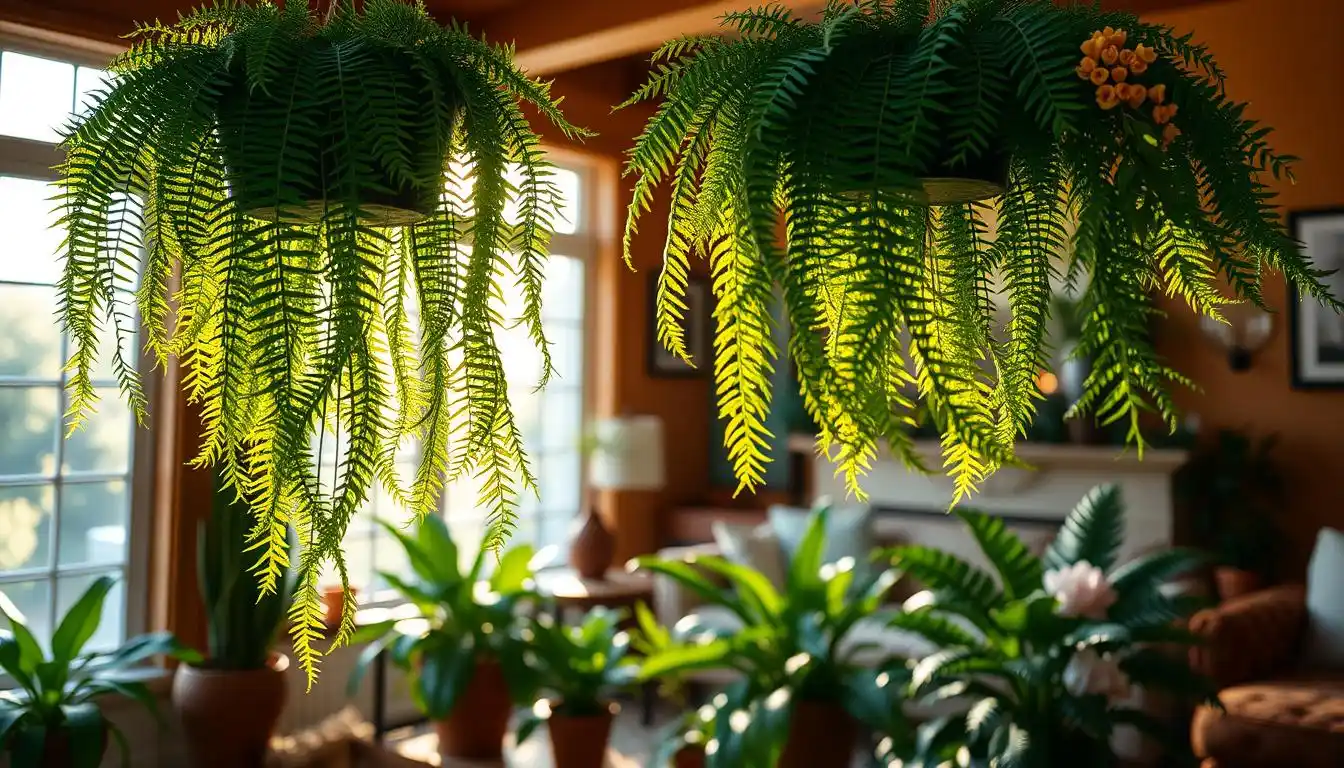Adding indoor greenery can instantly brighten up your living spaces. Hanging ferns are a great choice. They bring natural beauty, purify the air, and create a peaceful vibe.
Hanging ferns can make your home feel serene and calm. They’re great for adding a decorative touch to any room. Plus, they fit well with many decorating styles.
Key Takeaways
- Enhance your living spaces with indoor greenery
- Hanging ferns purify the air and create a calming atmosphere
- Add a decorative element to any room with hanging ferns
- Suitable for various decorating styles
- Create a sense of serenity and tranquility in your home
The Natural Beauty of Indoor Greenery
Indoor greenery can turn your living space into a vibrant oasis. Adding plants like ferns to your decor boosts your home’s look. Ferns, in particular, bring a touch of nature indoors, making your space calm and serene.

How Plants Transform Living Spaces
Plants can change your living space by adding a natural touch. Ferns, with their delicate fronds and lush green color, brighten any room. They can fill empty corners, add texture to shelves, or be a centerpiece on a dining table.
Also, indoor greenery can purify the air and make your indoor environment better. By picking the right plants, like ferns, you can make a healthier space that promotes well-being.
The Psychological Benefits of Living with Ferns
Living with ferns offers many psychological benefits. Studies show that plants can lower stress, improve mood, and boost productivity. The calming presence of ferns can create a sense of serenity, making them perfect for bedrooms, living rooms, or any space for relaxation.
Moreover, caring for ferns can be therapeutic. It gives you a sense of purpose and fulfillment. By tending to your plants, you connect more with nature and improve your mental health.
Popular Hanging Ferns for Your Home
Hanging ferns can make your home look better. They add greenery and bring a calm, natural feel. There are many types to choose from.
Boston Fern: The Classic Choice
The Boston fern is a classic choice. It has lush, green fronds that look great in hanging baskets. It likes bright, indirect light and needs a lot of water, making it perfect for bathrooms or kitchens.
Maidenhair Fern: Delicate and Elegant
The Maidenhair fern is known for its delicate fronds. It adds elegance to any room. It prefers bright, indirect light and high humidity, making it great for spaces with good air flow.
Bird’s Nest Fern: Sculptural and Bold
The Bird’s Nest fern is bold and striking. Its broad fronds form a nest-like shape. It’s easy to care for and can do well in low light, making it perfect for rooms with little natural light.
Staghorn Fern: Unique and Dramatic
The Staghorn fern is unique and dramatic. Its antler-like fronds add exotic beauty. It needs bright, indirect light and regular watering, making it a great choice for a statement piece.
Button Fern: Compact and Charming
The Button fern is small and charming. Its small fronds add whimsy to hanging baskets. It’s easy to care for and can do well in different lighting conditions.
| Fern Type | Lighting Requirements | Humidity Needs |
|---|---|---|
| Boston Fern | Bright, indirect light | High humidity |
| Maidenhair Fern | Bright, indirect light | High humidity |
| Bird’s Nest Fern | Low to bright, indirect light | Moderate humidity |
| Staghorn Fern | Bright, indirect light | High humidity |
| Button Fern | Varied lighting conditions | Moderate humidity |

Selecting the Perfect Hanging Ferns for Different Rooms
Choosing the right hanging fern for your space is key. You need to think about your room’s light, humidity, and temperature. Each room in your home has its own special conditions.

Assessing Light Conditions in Your Home
Light is very important when picking hanging ferns. Some ferns need lots of light, while others prefer less. For example, the Boston Fern loves bright, indirect light. On the other hand, the Maidenhair Fern does well in softer light. Check your room’s light to pick the right fern.
Considering Humidity and Temperature Requirements
Ferns like it humid, between 40-60% relative humidity. You can make the air around them more humid by misting or using a humidifier. They also like daytime temperatures between 65-75°F (18-24°C) and cooler nights. Make sure to check the temperature needs of the fern you want.
Matching Fern Size to Your Space
The size of your fern should match your space. Big ferns look great in large rooms, while small ones fit better in smaller areas. Think about the fern’s full size when picking a spot and container.
Best Ferns for Bathrooms and Kitchens
Bathrooms and kitchens are usually more humid, perfect for some ferns. The Bird’s Nest Fern and Staghorn Fern do well here. Just make sure the light in these rooms is right for your fern.
Essential Care Guide for Hanging Ferns
To keep your hanging ferns thriving, it’s crucial to understand their specific care requirements. Hanging ferns can be a beautiful addition to any home. But, they demand attention to detail in their care.
Watering Requirements and Techniques
Watering is a critical aspect of fern care. Hanging ferns prefer moist soil, but overwatering can lead to root rot. Check the soil moisture by sticking your finger into the soil up to the first knuckle; if it feels dry, it’s time to water. Use lukewarm water to prevent shocking the roots.
Watering Tips:
- Water your ferns when the top inch of soil feels dry.
- Avoid getting water on the fronds to prevent spotting.
- Use a well-draining potting mix to prevent waterlogged soil.
Light and Temperature Management
Managing light and temperature is vital for the health of your hanging ferns. Most ferns prefer bright, indirect light. Direct sunlight can scorch the fronds, while too little light can cause weak and spindly growth.
| Fern Type | Preferred Light | Temperature Range |
|---|---|---|
| Boston Fern | Bright, indirect | 65-75°F (18-24°C) |
| Maidenhair Fern | Low to moderate | 60-70°F (15-21°C) |
| Bird’s Nest Fern | Bright, indirect | 65-75°F (18-24°C) |
Humidity Control for Thriving Ferns
Ferns thrive in humid environments, typically between 40-60% relative humidity. To maintain the right humidity, you can place the fern on a tray filled with water and pebbles or use a humidifier nearby.
Fertilizing Schedule and Methods
Fertilizing your hanging ferns is essential for their growth and health. Use a balanced, water-soluble fertilizer during the growing season (spring and summer). Dilute the fertilizer to half the recommended strength to avoid burning the roots.
Fertilizing Tips:
- Fertilize your ferns every 2-4 weeks during the growing season.
- Reduce fertilizing to once a month during the fall and winter.
- Consider using a fertilizer specifically formulated for ferns.
Creative Ways to Display Hanging Ferns Indoors
There are many ways to make your hanging ferns stand out indoors. By picking the right display method, you can make them the main attraction in any room. This adds life and color to your space.
Macramé Hangers and Decorative Baskets
Macramé hangers give hanging ferns a bohemian vibe. They match the plants’ natural beauty. Decorative baskets, meanwhile, offer a rustic or traditional look. Both can make your space unique.
Window Arrangements and Plant Groupings
Putting hanging ferns near windows makes for a stunning display. Mixing them with other plants maximizes space and looks lush. Try using plants of different heights and textures for more interest.
Unexpected Locations for Hanging Fern Displays
Don’t stick to usual spots like living rooms or bedrooms. Ferns can do well in hallways, stairwells, or kitchens with enough light and humidity. Trying out new spots can lead to exciting displays.
Creating a Fern Sanctuary in Your Home
Imagine a fern sanctuary in your home. It could be a whole room or a part of one filled with ferns and other plants. Such a space offers a peaceful retreat, bringing forest calm indoors.
| Display Method | Description | Ideal Location |
|---|---|---|
| Macramé Hangers | Bohemian style, natural look | Living rooms, bedrooms |
| Decorative Baskets | Rustic or traditional look | Hallways, kitchens |
| Window Arrangements | Layered, lush display | Near windows |
| Plant Groupings | Varied heights and textures | Any room with sufficient light |
Outdoor Ferns in Pots and Hanging Displays
Make your outdoor space beautiful with ferns in pots and hanging displays. Ferns can turn your porch, patio, or garden into a lush oasis. With the right care, these plants can thrive outdoors, enhancing your outdoor living areas.
Best Ferns for Outdoor Hanging Baskets
Some ferns are perfect for outdoor hanging baskets. The Boston fern is a favorite for its lush, green fronds. The Maidenhair fern adds elegance with its delicate fronds. The Bird’s Nest fern offers a unique, sculptural look.
- Boston fern: Ideal for hanging baskets due to its trailing growth habit.
- Maidenhair fern: Adds a touch of elegance with its delicate fronds.
- Bird’s Nest fern: Provides a unique, sculptural element to your outdoor decor.
Arranging Ferns on Your Front Porch
Arranging ferns on your front porch creates a welcoming space. Mix ferns of different sizes and textures for depth. Hang baskets from the ceiling or use stands for a layered look. Combine ferns with other shade-loving plants for a lush display.
Use decorative baskets or planters that match your porch’s style. A rustic wooden planter adds charm, while a modern metal basket looks sleek.
Seasonal Considerations for Outdoor Ferns
Outdoor ferns need protection from seasonal changes. In cold climates, protect them from frost by bringing them inside or insulating them. In hot weather, keep them moist and shaded from direct sunlight.
“Ferns are a great choice for outdoor decor because they can thrive in a variety of conditions, but they do require some care to survive the changing seasons.”
Protecting Outdoor Ferns from Elements
To shield your ferns from harsh weather, use a windscreen or place them in a sheltered spot. Check your ferns for stress signs like yellow fronds and adjust their care. Mulching around potted ferns helps keep moisture in and soil temperature stable.
By following these tips, you can enjoy your outdoor ferns all year. They will add natural beauty to your home’s exterior.
Boston Fern Care Outdoors: A Complete Guide
To keep your Boston ferns thriving outside, it’s essential to provide them with the right conditions. Boston ferns are versatile plants that can add beauty to your outdoor space when properly cared for.
Ideal Conditions for Boston Ferns Outside
Boston ferns prefer shaded or partially shaded areas outdoors. Direct sunlight can cause the fronds to become scorched, so it’s best to place them under a tree or a shaded patio.
Temperature and Humidity: Boston ferns thrive in temperatures between 65°F and 75°F (18°C to 24°C). They also require high humidity to thrive. If your area is dry, consider using a humidifier or misting the ferns regularly.
Watering and Feeding Outdoor Boston Ferns
Watering is crucial for outdoor Boston ferns. They need consistent moisture, especially during hot weather. Check the soil daily, and water when the top inch of soil feels dry.
Fertilization: Feed your Boston ferns with a balanced fertilizer during the growing season (spring and summer). Dilute the fertilizer to half the recommended strength to avoid burning the roots.
| Season | Watering Frequency | Fertilization |
|---|---|---|
| Spring | Regularly, as soil dries | Balanced fertilizer, diluted |
| Summer | Daily, if hot and dry | Balanced fertilizer, diluted |
| Fall | Reduce frequency | No fertilization |
| Winter | Minimal, keep slightly moist | No fertilization |
Protecting Boston Ferns from Pests and Disease
Outdoor Boston ferns can be susceptible to pests like slugs, snails, and scale. Inspect your plants regularly and treat any infestations promptly.
Disease Prevention: To prevent fungal diseases, ensure good air circulation around your ferns and avoid overhead watering.
Overwintering Your Boston Ferns
In colder climates, Boston ferns may need protection during winter. Bring them indoors or cover them with a frost blanket to protect from frost.
Storage: If bringing indoors, place them in a bright, cool area. Reduce watering to once a month, as they are dormant.
Troubleshooting Common Problems with Hanging Ferns
Troubleshooting is key to keeping hanging ferns healthy and thriving. Despite their beauty and easy care, ferns can face issues that harm their health and look. It’s important to address these problems quickly.
Addressing Yellowing or Browning Fronds
Yellow or brown fronds on your ferns might mean a few things. Overwatering can cause root rot. On the flip side, underwatering stresses the plant, leading to color changes. Adjust your watering based on your home’s humidity and temperature.
Another reason could be not enough light. Ferns love bright, indirect light. If your fern isn’t getting enough, move it to a brighter spot or use grow lights.
Dealing with Pest Infestations
Pests like spider mites, mealybugs, or scale are common on hanging ferns. Regularly check your plants for these pests. If you find any, isolate the plant to stop the problem from spreading.
To treat pests, gently wash the fronds with insecticidal soap or neem oil. Follow the product’s instructions to make sure you get rid of all pests.
Reviving a Struggling Hanging Fern
If your fern is struggling, it might need a care change. First, check its watering and fertilization schedule. Make adjustments to ensure it gets the right moisture and nutrients.
Think about repotting the fern if it’s been in the same pot for a while. New potting mix can give it the nutrients it’s missing.
When and How to Repot Your Ferns
Repotting your hanging ferns is important for their health. Ferns usually need a new pot every 1-2 years as their roots grow.
Choose a slightly larger pot and use a mix that drains well to avoid waterlogged soil. Be gentle with the roots when repotting to reduce stress on the plant.
Conclusion: Transforming Your Living Space with Hanging Ferns
Hanging ferns can change your living space in amazing ways. They add natural beauty and make your home or outdoor areas more welcoming. This creates a refreshing and inviting atmosphere.
Choosing the right ferns and caring for them properly is key. You can brighten up your indoor spaces with a Boston fern or add flair to your outdoor porch with a staghorn fern. Knowing what your ferns need will help them thrive, bringing joy and peace into your life.
Exploring hanging ferns opens up many possibilities for your living spaces. You can find creative ways to display them and enjoy the process of nurturing your plants. Hanging ferns let you connect with nature and improve your surroundings. By embracing their beauty and versatility, you’re on your way to a more harmonious and beautiful home.
FAQ
How do I care for a Boston fern outside?
To care for a Boston fern outside, place it in a shaded or partially shaded area. Water it regularly to keep the soil moist. Fertilize during the growing season. Also, protect it from extreme temperatures and pests.
What are the best ferns for outdoor hanging baskets?
Boston ferns, maidenhair ferns, and staghorn ferns are great for hanging baskets outside. They are easy to care for and can thrive in outdoor conditions with the right care.
How do I arrange ferns on my front porch?
When arranging ferns on your front porch, consider their mature size. Leave enough space for air to circulate. Hang them from the ceiling or place them on a table or floor. Mix different textures and sizes for a nice look.
Can I use ferns in outdoor pots, and how do I care for them?
Yes, you can use ferns in outdoor pots. Choose a pot that drains well and use a potting mix for ferns. Water and fertilize regularly. Also, protect them from extreme weather.
How do I protect my outdoor ferns from pests and diseases?
To protect your ferns, regularly check for pests or diseases. Use organic or chemical controls as needed. Also, keep your ferns clean by removing dead fronds.
What are the ideal conditions for Boston ferns outside?
Boston ferns like shaded or partially shaded areas with high humidity. They prefer temperatures between 65°F to 75°F (18°C to 24°C). They need moist, well-draining soil and regular watering and fertilization.
How do I overwinter my Boston ferns?
To overwinter your Boston ferns, bring them indoors or to a protected area before the first frost. Reduce watering and fertilization in winter. Protect them from extreme cold and dryness.
Can I hang ferns in my bathroom or kitchen?
Yes, you can hang ferns in your bathroom or kitchen. These rooms are often more humid, which ferns like. Just make sure they get the right amount of light.

